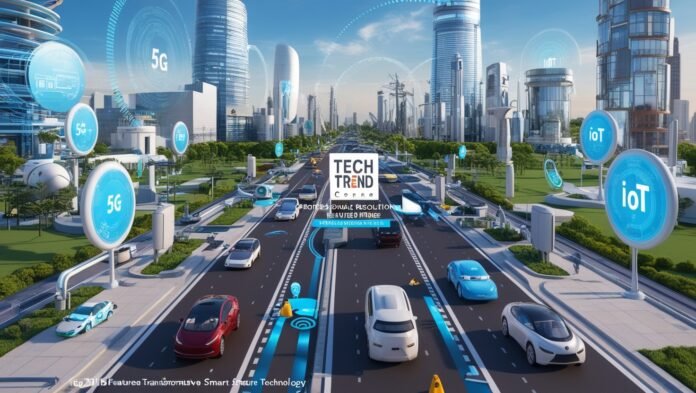Over the years, discussions about 5G technology have become very popular, and rightly so. As the fifth generation mobile network, 5G enables the world to connect, work, and live better. 5G Technology in 2025 will transform the technology landscape over the next five years with unprecedented speeds, ultra-low latency, and vast network capacity. This article delves into how 5G technology, starting in 2025, will affect many industries and societies and describes the challenges we must face. It also details how to redefine solutions previously considered impossible.
What is 5G Technology Really About?
Before exploring the exciting advances of 5G technology awaiting in 2025, we must clarify what 5G is and how it differs from previous mobile networking generations.
The fifth generation, known as 5G, succeeds the fourth generation or 4G. While 4G introduced faster internet speeds, 5G brings extraordinary data speeds, significantly lower latencies, and new levels of network capacity. Thus, 5G networks can multiplex many unique devices simultaneously, fostering the nascent wave of technological evolution, especially in areas like the Internet of Things (IoT), self-propelling vehicles, and smart cities.
Experiencing mobile internet with 5G technology provides speeds nearly 100 times faster than 4G. This enables downloading large files, enjoying high-definition content, and running applications with almost no delays. These possibilities will lead to innovative developments across various aspects of life, from healthcare to entertainment.
The Journey of 5G Technology: From 2020 to 2025
This is the story of 5G, evolving from a high-speed network available only in select cities by 2025 into a globally integrated system that underpins various aspects of modern life. The transformation journey involves several critical stages:
- The Phase of Early Adopters and Infrastructural Gathering (2020-2022): In the initial days of the 5G launch, networks were available only in urban hubs. This phase focused on infrastructure, progressing towards fiber optic cable implementation and constructing wireless small cells and network equipment. Few high-end smartphones and devices supported 5G, and network coverage remained limited to a few mega cities.
- Expansion and Integration (2023-2024): By 2023, 5G rolled out more extensively across urban and rural areas, reaching more countries worldwide. More devices, such as smartphones, wearables, and laptops, became compatible with 5G, offering faster downloads, seamless streaming, and better connectivity with increased public capacity. Applications like virtual reality (VR), augmented reality (AR), and smarter public transportation systems began to take off.
- Full Integration and Advanced Saturation Possibilities (2025): By 2025, 5G technology exploded into the innovation scene. It was no longer limited to mobile devices but infiltrated high-tech features like autonomous vehicles and smart homes. Advanced manufacturing also adopted 5G. Networks covered most of the world, providing high-speed, reliable internet access through an extensive connection network. This enabled numerous 5G applications affecting daily life, such as smart cities and revolutionary medical care provisions.
Effects of 5G Technology in 2025
By 2025, 5G has revolutionized industries and daily life with ultra-fast speeds and low latency. In healthcare, it enables remote surgeries and real-time monitoring. Transportation benefits from autonomous vehicles and smart traffic systems, while smart cities thrive on interconnected infrastructure. Enhanced mobile experiences include high-definition streaming and immersive AR/VR applications. Additionally, the Internet of Things (IoT) flourishes, allowing millions of devices to communicate seamlessly, boosting efficiency and innovation globally.
1. Transformation in Healthcare
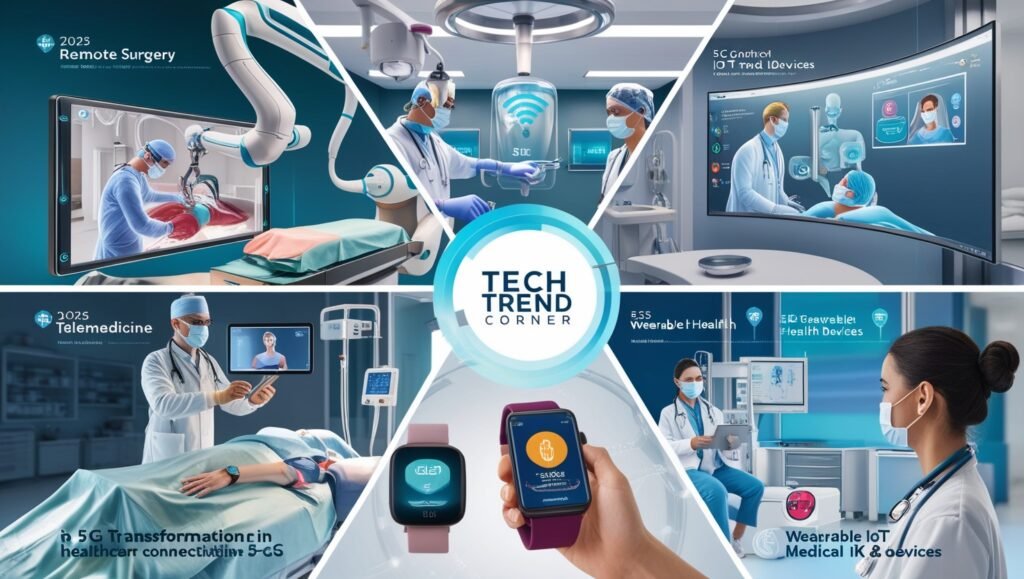
5G technology revolutionized healthcare with extremely low latency and high data rates, transforming patient lives and medical service delivery. Thus, 5G enabled:
- Remote Surgery: Surgeons performed operations remotely using robotic systems controlled in real-time via 5G connections. This allowed skilled surgeons to treat patients in underserved or remote areas, saving many lives without travel.
- Telemedicine and Virtual Consultations: Telemedicine advanced with high-definition video consultations, quicker diagnoses, and customized treatments. Physicians conducted real-time video calls to assess patients’ health using 5G’s bandwidth and low-latency communications.
- Wearable Health Devices: Devices like smartwatches and fitness trackers monitored patients’ vital signs constantly, sending real-time data to doctors. 5G’s capacity handled large amounts of data from these devices, allowing healthcare organizations to monitor patient health in real-time.
2. Revolutionizing Transportation
Transportation underwent significant transformation through 5G by 2025. 5G served as the backbone for autonomous, connected transportation systems, creating safer, more efficient, and sustainable transportation networks. Here’s how 5G brought changes:
- Self-driving Cars: Ultra-low latency allowed autonomous vehicles to communicate in real-time with each other and surrounding infrastructure, such as streetlights and road sensors. This communication made roads safer, resulting in fewer traffic accidents due to instant vehicle reactions to changing conditions.
- Vehicle-to-Everything (V2X): Native 5G support enabled communication between vehicles, pedestrians, and infrastructures, forming a truly connected transport network. This improved traffic management, reduced congestion, and enhanced travel experiences.
- Traffic Flow Management: Cities monitored and managed traffic efficiently using 5G. Smart lights and instantaneous traffic data helped commuters find the fastest routes, minimizing time spent in congestion.
3. Construction of Smart Cities
Smart cities grew phenomenally over the last decade, and by 2025, 5G technology formed their backbone. 5G network advancements enabled:
- Intelligent Infrastructure: Sensors embedded in buildings, roads, and other infrastructure gathered real-time data, allowing cities to optimize energy use, manage waste, and use resources efficiently.
- Public Safety: Low latency improved emergency services’ response times for incidents. Real-time sensor, camera, and drone data enhanced public safety and emergency response.
- Environmental Monitoring: 5G enabled real-time environmental monitoring of air quality and water usage. This information helped design more sustainable cities and reduce carbon footprints.
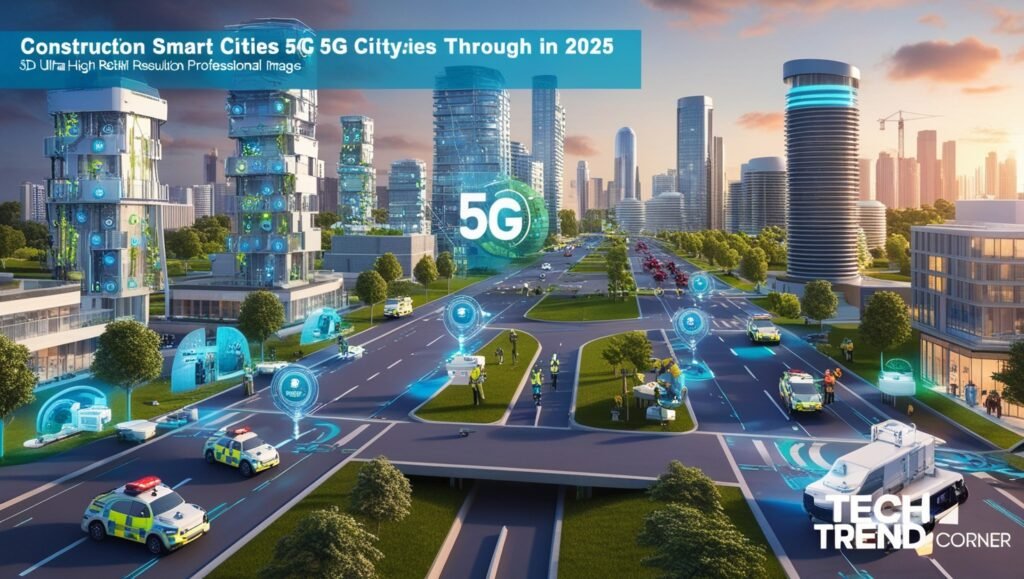
4. Emphasis on Mobile Experiences Enhancement
By 2025, 5G significantly improved mobile user experiences, making them faster, richer, and more seamless:
- Ultra High Definition Streaming: 5G allowed streaming in 4K and even 8K standards without buffering or lag, providing smoother and more enjoyable experiences.
- More Intensive Augmented and Virtual Reality (AR/VR): 5G’s speed and low latency enabled richer AR and VR experiences for gaming, education, and training. Users interacted in real-time with digital worlds without delays.
- World-Class Ubiquitous Connectivity: 5G connections remained uninterrupted in busy cities and remote places, allowing people to connect and work from anywhere on Earth at any time.
5. Internet of Things (IoT)
5G technology powered the IoT ecosystem with sophistication, enabling millions of devices to work without conflict. This development provided:
- Smart Homes: 5G drove new generations of smart home devices, from intelligent thermostats to voice-activated lights, making homes consume less energy and easier to manage.
- Industrial IoT: Factories and warehouses connected and automated machines through 5G, strengthening production and enhancing decision-making speed.
- Healthcare Devices: 5G enabled healthcare devices to operate in synergy, allowing real-time patient measurements and evaluations by health professionals.
The Challenges That Will Face 5G Technology in 2025
By 2025, 5G faces significant challenges including substantial infrastructure investment, limited spectrum availability, heightened cybersecurity risks, regulatory and standardization hurdles, and high adoption costs, requiring collaborative solutions for successful implementation.
- Development of Infrastructure: Rolling out 5G technology required substantial investment in infrastructure coverage, including fiber optic cables, small cell stations, and upgrades to existing towers. This investment was heavy and complex, often taking longer in rural areas where infrastructure needs were greater.
- Spectrum Availability: To perform optimally, 5G networks needed a guaranteed amount of allocated radio spectrum. Higher frequencies allowed higher data rates but limited range. Countries had to manage spectrum resources to meet 5G demands, requiring government and policy bodies to collaborate on frameworks ensuring optimum usage.
- Cybersecurity Risks: The increase in connected devices expanded opportunities for cybersecurity breaches. As IoT advanced with 5G, the attack surface for cybercriminals grew. Protecting sensitive personal and business data transmitted over 5G networks became crucial. Telecom companies, governments, and tech developers prioritized robust encryption, authentication protocols, and security measures to safeguard user privacy and prevent malicious acts.
- Regulatory and Standardization Challenges: Telecommunications standards varied across countries. As global 5G adoption improved, common standards and norms for implementing 5G infrastructure became essential for smooth rollouts. Conflicting regulatory approaches affected 5G progress speed and complicated international cooperation.
- Cost of Adoption: While 5G offered many benefits, the costs of infrastructure and equipment upgrades were enormous. Governments and telecom companies needed to balance investment with user demand to avoid transferring costs to consumers. Businesses and governments required careful budget and resource management, as the 4G to 5G transition involved significant planning and investment.
The Future of 5G Technology in 2025: Opportunities and Innovations
From 2025 onward, 5G technology unlocked great innovations and opportunities across various sectors, transforming industries and consumers’ daily lives.
- Smart Retail: 5G networks connected numerous devices in retail spaces, such as smart shelves, automated checkouts, and real-time inventory tracking. This connectivity allowed retailers to create personalized, digital experiences in physical stores, enabling shopping anytime, anywhere, satisfying customers quickly and speeding up processes.
- Gaming: 5G’s ultra-low latency and high speed ushered in a new era in mobile gaming. Cloud gaming became the norm, allowing players to stream games instead of downloading or installing them. Gamers enjoyed high-definition games on mobile phones and tablets without expensive hardware. Multiplayer gaming also became almost instantaneous.
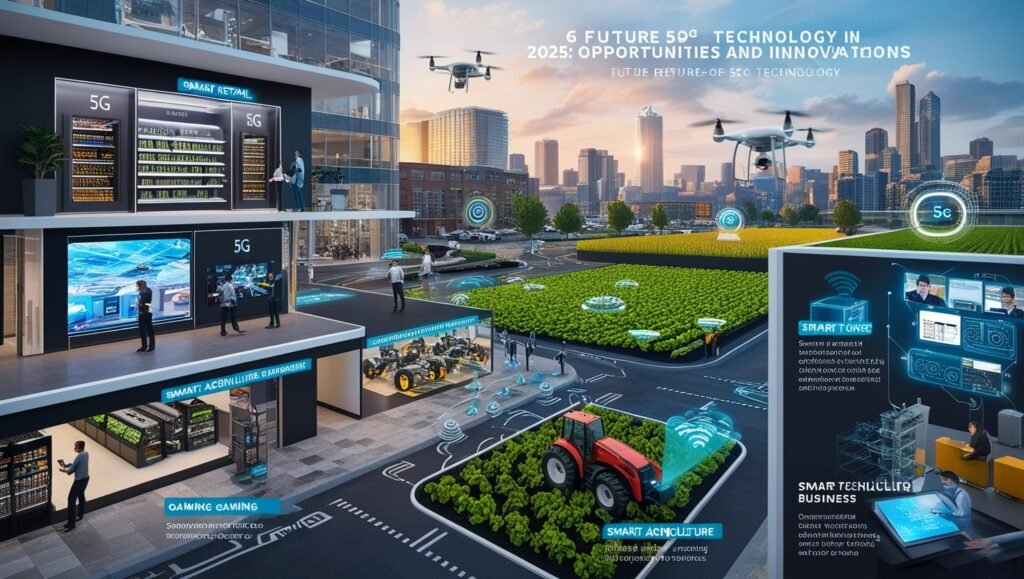
- Agriculture: In 2025, 5G helped farmers optimize operations and improve yields. Smart farming systems with 5G-equipped sensors monitored soil conditions, weather patterns, and crop health in real-time. Autonomous farming equipment, such as drones and self-driving tractors, integrated seamlessly, enhancing efficiencies and reducing human labor.
- Education: Remote learning and virtual classes greatly benefited from 5G. Students in remote or underserved areas accessed online resources and engaged in real-time video communication with teachers and classmates using high-speed broadband. Augmented and virtual reality-based learning experiences became more interactive, helping students understand complex topics better.
How 5G Technology in 2025 Will Empower Businesses
By 2025, businesses worldwide realized the full capabilities and values of deploying 5G technology across all industries. Here’s how businesses benefited:
- Enhancing Remote Work: The shift to remote work accelerated by COVID-19 linked with 5G. Employees accessed cloud applications and storage, experienced high-definition video conferencing, and handled large data files without interruptions through 5G connections.
- Automation and Industry 4.0: 5G merged automation, AI, and IoT within Industry 4.0. Businesses optimized production lines, strengthened supply chains, and improved operational efficiency using these technologies supported by 5G.
- Customer Experience: 5G enabled businesses to provide personalized real-time services. AI chatbots, video calls, and interactive advertisements allowed businesses to engage customers on a new level. Real-time data from connected devices informed targeted marketing and enhanced products.
- Edge Computing: 5G induced edge computing, allowing data processing near its source rather than in centralized cloud data centers. This reduced latency and sped up decision-making based on real-time information. Edge computing became crucial for applications like autonomous vehicles and smart cities that required instant data processing.
Conclusion
The future for 5G Technology in 2025 is promising. By 2025, 5G changed industries, transformed various life aspects, and provided previously unimaginable opportunities. 5G created a more connected and efficient world with greater speeds, lower latencies, and higher capacities.
Whether transforming healthcare and transportation, enhancing mobile experiences, or building smart cities, 5G fostered innovations that leveraged its capabilities. Challenges like infrastructure development, spectrum allocation, cybersecurity, and regulatory standards remained hurdles. Overcoming these challenges was crucial for 5G’s success and widespread adoption by 2025.
5G continued shaping the future as it matured in the coming years. Consumers and businesses experienced radical transformations, with 5G redefining life, work, and connectivity. As an enabler of autonomous vehicles, enhanced healthcare, and improved remote work conditions, 5G advanced the world beyond our imagination. The full potential of 5G promised the brightest future ahead.
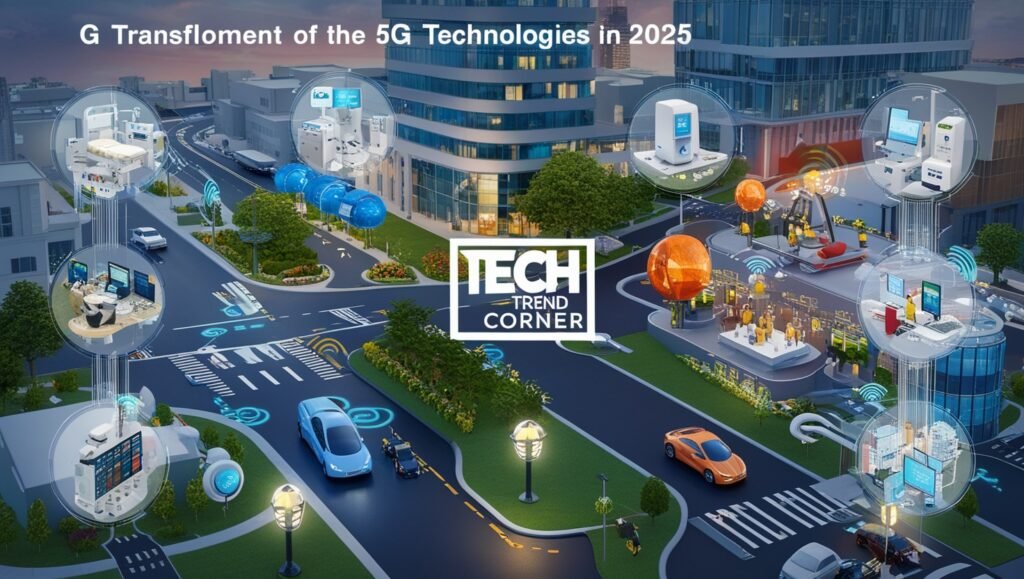
Read more about Augmented Reality Mobile Apps: Revolutionizing Daily Life.
Frequently Asked Questions
1. What makes 5G technology different from its previous generation, which is 4G?
5G technology is nearly 100 times faster, offers ultra-low delays, and supports more network connections. It handles more devices simultaneously, enabling advancements like the Internet of Things, autonomous vehicles, and smart cities.
2. What changes will 5G bring to the healthcare sector by 2025?
5G enables remote surgery, high-definition telemedicine consultations, and real-time data from wearables for daily health monitoring, improving service quality and healthcare access.
3. What are the primary barriers to the universalization of 5G in 2025?
Challenges include infrastructure investment, spectrum availability issues, increased cybersecurity risks, regulatory and standardization problems, and high adoption and equipment upgrade costs.
4. How will 5G impact transportation systems?
5G enables vehicle-to-vehicle communication with real-time traffic alerts for self-driving cars. V2X applications support big data analytics and smart infrastructure communication, improving traffic management and transportation safety.
5. How will 5G technology benefit business enterprises?
Businesses enhance operations with advanced remote work, gain productivity through improved automation, offer better customer experiences with real-time services, and make faster decisions using edge computing.

